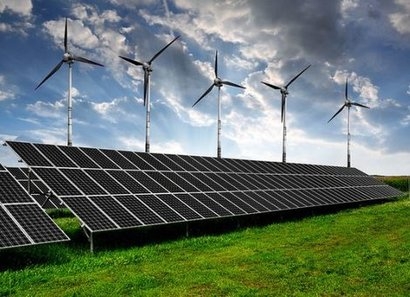
While available wind resources have declined, solar plant performance in many European markets has increased, providing an effective demonstation of the benefits of the balancing effect provided by installation of both technologies as part of an overall diversified, clean energy portfolio. This effect is clearly conveyed by wind and solar performance maps of Europe provided by environmental and industrial measurement company Vaisala.
A similar finding was obtained recently by Green Business Watch, reported by REM yesterday, showing that some counties in the UK are failing to fully exploit the currently available opportunities for solar generation.
The Vaisala maps show that wind farm operators saw the available resource in July dip by as much as 20 percent from long-term averages, while solar irradiance in many of the same markets was up to 20 percent above average.
Wind energy asset owners and operators in the UK, France, Spain and parts of Germany, have suffered from wind speeds that have been substantially below par during July, following similarly low winds in May and June. In Scotland, meanwhile, wind speeds have been uniformly down for the whole seven months of 2018. This trend is likely to have a long-term impact on the financial performance of Scottish wind farms, and has already been noted in the financial results of major utilities.
The high-pressure system over Europe which has caused these anomalous conditions is expected to persist until October. These conditions follow another notable ‘wind drought’ across the US in 2015, which had a widespread financial impact.
Stakeholders in the European renewable energy sector should be encouraged by the July 2018 solar irradiance data, showing a negative correlation between deviations in wind speeds and deviations in solar irradiance. When wind was below average, sunshine was above average. Vaisala has also determined that correlation pattern holds over the long-term across most of Europe but it varies from region to region as one looks globally. This conclusion is explored elsewhere in another fascinating finding by Vaisala.
"The 2015 conditions caused many wind energy investors in the US to think very seriously about how they could diversify their portfolios, not just geographically, but also by technology" said Dr. Pascal Storck, Director of Renewable Energy, Vaisala. "This new data shows that large-scale anomalies are not a one-time occurrence, and it may be time for the European market to follow suit in thinking about how it can become 'climate resilient'.
Mr Storck added that wind and solar technologies are often portrayed as playing against each other, but that the reality is actually that a diverse portfolio, obtained by building out both, to a large scale, will be the solution to long-term variability of this nature. Energy storage has a role to play in smoothing out fluctuations at an hourly or perhaps daily basis, but using storage to manage variability on a monthly basis is likely to be cost-prohibitive.
The importance of diversification has been clearly displayed in Germany. While the country’s installed wind and solar capacity have both increased in the last year, wind energy production for July 2018 was 20 percent lower than the same month in 2017 – a drop of 1.1 TwH in generation, or the equivalent of a 10 GW reduction in generation capacity (assuming a typical summer capacity factor of 15 percent). However, this shortfall was more than compensated for by a 26 percent– or 1.4 TwH – increase in its solar energy production in the same period.
However, not all markets saw this balancing effect. Portugal, for example, experienced both low winds and low irradiance in July. This highlights the need for robust forecasting and financial planning on a project-by-project basis to account for the impact of site-specific conditions on energy production and returns.
According to Storck, this shows that investment in robust, site-specific weather and climate data ultimately remains a critical requirement – particularly as the European market enters a post-subsidy phase in which project margins are getting tighter and the impact of any resource shortfall is felt more keenly than ever.
Vaisala has recently launched a Climate Reference Tool, a free-to-access online service that displays global anomalies in wind speeds, enabling project and portfolio owners to situate asset performance in a long-term context.
For additional information:

